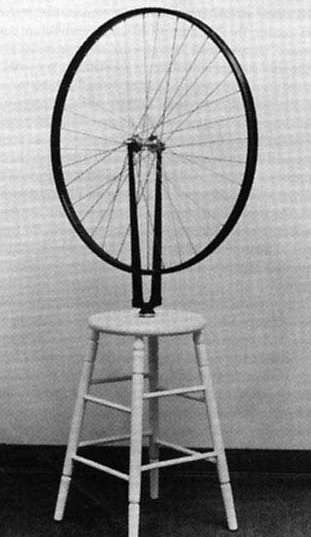It
has been written that “excellence as a practice does not
apply to fine art,” which begs the value ‘fine’
when specifying the kind of art.  When
Duchamp proposed the ready-made as a work of art he raised the
question whether it really is one, and he himself said it was
not. Duchamp said he didn't understand the work till near the
end of his life. "The curious thing about the Readymade
is that I've never been able to arrive at a definition or explanation
that fully satisfies me." -- Marcel Duchamp (Tomkins p159).
This allows that some meaning may yet be found tucked behind
a blind spot.
When
Duchamp proposed the ready-made as a work of art he raised the
question whether it really is one, and he himself said it was
not. Duchamp said he didn't understand the work till near the
end of his life. "The curious thing about the Readymade
is that I've never been able to arrive at a definition or explanation
that fully satisfies me." -- Marcel Duchamp (Tomkins p159).
This allows that some meaning may yet be found tucked behind
a blind spot.
Dario
Gamboni, in The Destruction of Art, Iconoclasm and Vandalism
tells us that “At the end of his life in 1964 he explained
to Otto Hahn that his Readymades had aimed at drawing ‘the
attention of the people to the fact that art is a mirage’
even if ‘a solid one,’ and concluded from the vagaries
of taste that history was to be doubted.” (Gamboni p260).
Duchamp then believed in distant qualities that our ‘inadequate’
art reflects, as a mirage reflects a distant reality. Science
tells us that aesthetics and art are a crucial aspect of evolutionary
development, and psychology says art is vital for mental health.
This contradicts Duchamp’s conclusions. Art is not a mirage
but a tangible essential process, and changing tastes validate
art history instead of raising doubt. In fact history itself
is a consciousness of change. We now revise our art history
to reflect Duchamp creating the Readymade as a placeholder and
a pretence, a mirage and not real art.
Duchamp
also said as a Dadaist he wanted to destroy art but as we see
below he destroyed his own ability to make art. In a 1998 panel
discussion titled Vision and Visuality chaired by Hal
Foster and sponsored by the Dia Art Foundation, Rosalind Kraus
mentioned that Duchamp despised optical art and disliked artisanal
work(Foster, p76). We would be surprised to read that Shakespeare
despised grammar, or that Stravinsky loathed musical notes.
Optical art requires years of skill, artisanal work is done
with concern; these are things to respect, not to despise. Detritus
does not compare to a sculpture or painting that took months
for the artist to execute after a lifetime of study. The ready-made
is not our best, not our excellence.
Marcel
Duchamp created his brand as a Dadaist by rejecting the Impressionists,
aesthetics and the artisan. The ready-made assumes that a factory-made
or found object is as good as any work by the artist. If you
say art is not worth making and you say it long enough, you
will believe yourself and eventually lose interest in making
art.
Duchamp
was not an impostor. He was a poseur. He posed questions without
knowing answers, as in not understanding the ready-made. He
acted knowing when in fact he seems to have been throwing ideas
at the wall to see which one would stick. Art had till then
been the highest expression of a culture. As a Dadaist Duchamp
said that trash was the highest expression of a culture. It
took us a hundred years to reply no.
In
the bicycle wheel we see some attractive chaotic elements as
the workers failed to make a perfect fit of the spokes. The
post bolted into the stool and the stool itself are mildly interesting
as historical objects of a bygone style. But these contributions
are so slight they are nothing more than encumbrances taking
up unnecessary cultural space. Quis custodiet ipsos custodes?
is a Latin phrase found in the work of the Roman poet Juvenal
from his Satires (Satire VI, lines 347, 8). It is literally
translated as “Who will guard the guards themselves?”